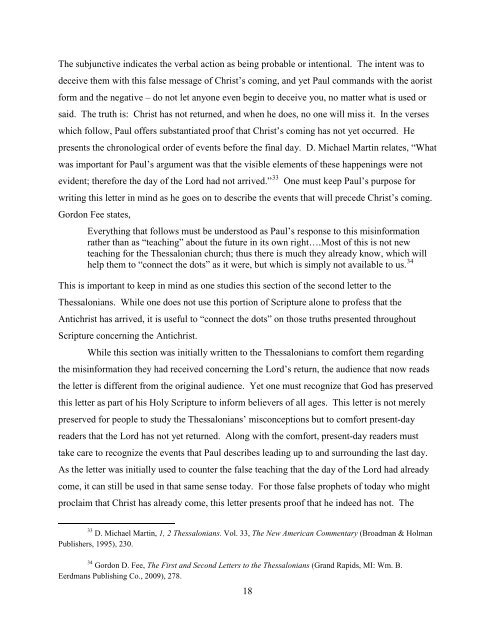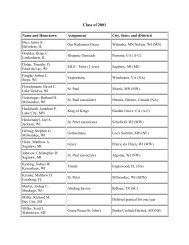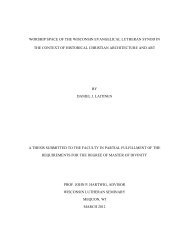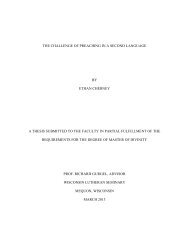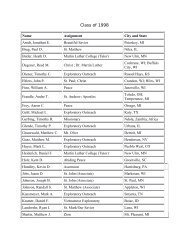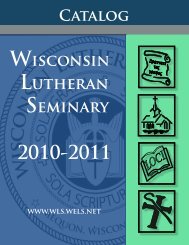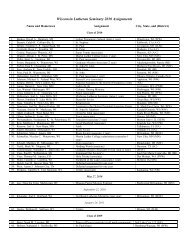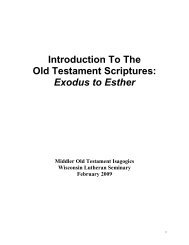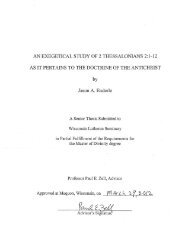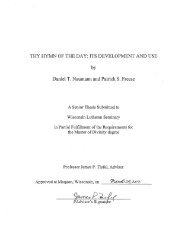Untitled - Wisconsin Lutheran Seminary - WELS
Untitled - Wisconsin Lutheran Seminary - WELS
Untitled - Wisconsin Lutheran Seminary - WELS
Create successful ePaper yourself
Turn your PDF publications into a flip-book with our unique Google optimized e-Paper software.
The subjunctive indicates the verbal action as being probable or intentional. The intent was to<br />
deceive them with this false message of Christ’s coming, and yet Paul commands with the aorist<br />
form and the negative – do not let anyone even begin to deceive you, no matter what is used or<br />
said. The truth is: Christ has not returned, and when he does, no one will miss it. In the verses<br />
which follow, Paul offers substantiated proof that Christ’s coming has not yet occurred. He<br />
presents the chronological order of events before the final day. D. Michael Martin relates, “What<br />
was important for Paul’s argument was that the visible elements of these happenings were not<br />
evident; therefore the day of the Lord had not arrived.” 33<br />
One must keep Paul’s purpose for<br />
writing this letter in mind as he goes on to describe the events that will precede Christ’s coming.<br />
Gordon Fee states,<br />
Everything that follows must be understood as Paul’s response to this misinformation<br />
rather than as “teaching” about the future in its own right….Most of this is not new<br />
teaching for the Thessalonian church; thus there is much they already know, which will<br />
34<br />
help them to “connect the dots” as it were, but which is simply not available to us.<br />
This is important to keep in mind as one studies this section of the second letter to the<br />
Thessalonians. While one does not use this portion of Scripture alone to profess that the<br />
Antichrist has arrived, it is useful to “connect the dots” on those truths presented throughout<br />
Scripture concerning the Antichrist.<br />
While this section was initially written to the Thessalonians to comfort them regarding<br />
the misinformation they had received concerning the Lord’s return, the audience that now reads<br />
the letter is different from the original audience. Yet one must recognize that God has preserved<br />
this letter as part of his Holy Scripture to inform believers of all ages. This letter is not merely<br />
preserved for people to study the Thessalonians’ misconceptions but to comfort present-day<br />
readers that the Lord has not yet returned. Along with the comfort, present-day readers must<br />
take care to recognize the events that Paul describes leading up to and surrounding the last day.<br />
As the letter was initially used to counter the false teaching that the day of the Lord had already<br />
come, it can still be used in that same sense today. For those false prophets of today who might<br />
proclaim that Christ has already come, this letter presents proof that he indeed has not. The<br />
33 D. Michael Martin, 1, 2 Thessalonians. Vol. 33, The New American Commentary (Broadman & Holman<br />
Publishers, 1995), 230.<br />
34 Gordon D. Fee, The First and Second Letters to the Thessalonians (Grand Rapids, MI: Wm. B.<br />
Eerdmans Publishing Co., 2009), 278.<br />
18


